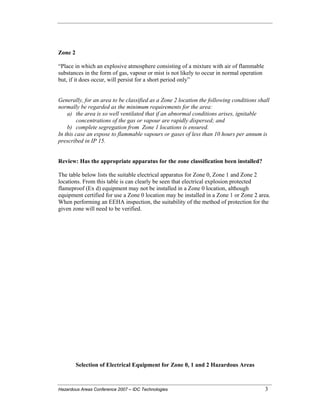The 2-Minute Rule for Roar Solutions
The 2-Minute Rule for Roar Solutions
Blog Article
Roar Solutions Can Be Fun For Everyone
Table of ContentsFascination About Roar SolutionsThe Single Strategy To Use For Roar SolutionsNot known Factual Statements About Roar Solutions
In order to safeguard setups from a possible explosion an approach of evaluating and categorizing a possibly harmful location is needed. The function of this is to ensure the appropriate selection and installation of tools to inevitably prevent a surge and to ensure safety of life.
(https://www.artstation.com/roarsolutions6/profile)
No equipment needs to be installed where the surface temperature level of the equipment is higher than the ignition temperature level of the given risk. Below are some typical dirt dangerous and their minimal ignition temperature level. Coal Dirt 380C 225C Polythene 420C (melts) Methyl Cellulose 420C 320C Starch 460C 435C Flour 490C 340C Sugar 490C 460C Grain Dust 510C 300C Phenolic Material 530C > 450C Aluminium 590C > 450C PVC 700C > 450C Residue 810C 570C The possibility of the threat being present in a focus high enough to cause an ignition will differ from area to place.
Dangerous area electric tools possibly made for usage in higher ambient temperatures. Area Fixing By Authorised Personnel: Complicated screening may not be required nonetheless specific treatments may require to be complied with in order for the tools to keep its 3rd celebration ranking. Each item of tools with an unsafe rating need to be examined separately.
The Basic Principles Of Roar Solutions
The equipment register is a thorough database of equipment records that includes a minimum collection of areas to recognize each product's place, technological specifications, Ex category, age, and environmental data. This info is important for tracking and managing the devices successfully within hazardous locations. On the other hand, for regular or RBI sampling evaluations, the quality will certainly be a combination of Comprehensive and Close evaluations. The proportion of Detailed to Shut evaluations will certainly be identified by the Devices Risk, which is examined based on ignition threat (the probability of a source of ignition versus the possibility of a combustible atmosphere )and the hazardous location category
( Zone 0, 1, or 2). This variant will additionally influence the resourcing requirements for work prep work. As soon as Whole lots are defined, you can establish sampling plans based upon the example size of each Whole lot, which describes the variety of random equipment products to be examined. To establish the called for example size, two facets require to be assessed: the dimension of the Great deal and the group of inspection, which indicates the degree of initiative that ought to be used( decreased, normal, or raised )to the inspection of the Great deal. By incorporating the group of assessment with the Lot size, you can then establish the suitable denial requirements for an example, meaning the permitted variety of faulty products found within that example. For even more information on this process, please describe the Power Institute Standards. The IEC 60079 basic recommends that the maximum interval in between evaluations ought to not surpass 3 years. EEHA evaluations will additionally be carried out outside of RBI projects as part of scheduled maintenance and devices overhauls or repair services. These assessments can be credited toward the RBI sample sizes within the influenced Great deals. EEHA evaluations are carried out to identify faults in electrical tools. A heavy scoring system is important, as a solitary tool might have numerous faults, each with differing levels of ignition threat. If the combined rating of both evaluations is much less than two times the fault score, the Lot is regarded appropriate. If the Lot is still taken into consideration inappropriate, it must go through a full examination or justification, which may activate more stringent Learn More Here evaluation procedures. Accepted Great deal: The reasons for any kind of mistakes are identified. If an usual failure mode is discovered, added tools might call for maintenance. Mistakes are classified by severity( Security, Stability, Home cleaning ), guaranteeing that urgent concerns are evaluated and dealt with without delay to alleviate any effect on safety and security or procedures. The EEHA data source should track and record the lifecycle of faults in addition to the rehabilitative actions taken. Carrying out a durable Risk-Based Examination( RBI )technique is crucial for making certain compliance and safety and security in taking care of Electrical Devices in Hazardous Locations( EEHA) (eeha courses). Automated Mistake Rating and Lifecycle Administration: Easily handle mistakes and track their lifecycle to enhance evaluation accuracy. The introduction of this assistance for risk-based inspection additionally enhances Inspectivity's setting as a best-in-class remedy for regulatory compliance, along with for any kind of asset-centric inspection use case. If you have an interest in finding out more, we invite you to request a demo and discover just how our option can change your EEHA administration processes.
Rumored Buzz on Roar Solutions

In regards to explosive risk, a hazardous area is an environment in which an explosive ambience exists (or might be expected to be present) in quantities that need unique precautions for the construction, installation and use of tools. eeha courses. In this write-up we explore the obstacles encountered in the office, the danger control actions, and the needed proficiencies to work safely
These materials can, in specific conditions, create eruptive atmospheres and these can have major and heartbreaking effects. Many of us are acquainted with the fire triangle eliminate any one of the three components and the fire can not take place, yet what does this mean in the context of dangerous areas?
In a lot of circumstances, we can do little about the degrees of oxygen in the air, however we can have significant impact on resources of ignition, for example electric equipment. Hazardous areas are documented on the harmful location category illustration and are recognized on-site by the triangular "EX-SPOUSE" indication. Right here, among various other key information, zones are split into 3 types depending upon the threat, the chance and duration that an explosive atmosphere will certainly exist; Zone 0 or 20 is deemed one of the most hazardous and Area 2 or 22 is deemed the least.
Report this page